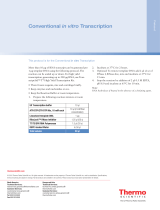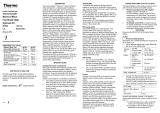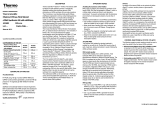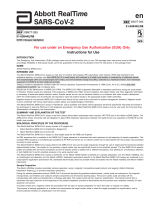Page is loading ...

RevertAid H Minus First Strand cDNA Synthesis Kit, with DNase I
Catalog Number K16315, K16325
Pub. No. MAN0025392 Rev. C.00
Contents and storage
Cat. No.
Contents
Amount
Storage
K16315
(20 rxn)
1 box of RevertAid H
Minus First Strand
cDNA Synthesis Kit
(Cat. No. K1631),
containing:
RevertAid H Minus Reverse Transcriptase (200 U*/µL)
1 x 25 µL
-25 °C to -15 °C
RiboLock RNase Inhibitor (20 U**/µL)
1 x 25 µL
5X Reaction Buffer
(250 mM Tris-HCl (pH 8.3), 250 mM KCl, 20 mM MgCl2, 50 mM DTT)
1 x 150 µL
10mM dNTP Mix
1 x 50 µL
Oligo(dT)18 Primer, 100 µM
1 x 25 µL
Random Hexamer Primer, 100 µM
1 x 25 µL
Forward GAPDH Primer, 10 µM
1 x 20 µL
Reverse GAPDH Primer, 10 µM
1 x 20 µL
Control GAPDH RNA, 0.05 µg/µL
1 x 20 µL
Water, nuclease-free
2 x 1.25 mL
1 box of DNase I
(Cat. No. EN0529),
containing:
DNase I, RNase-free (1 U/µL)
1 x 200 µL
10X Reaction Buffer with MgCl2 for DNase I
1 x 1.25 mL
50 mM EDTA
1 x 1 mL
K16325
(100 rxn)
1 box of RevertAid H
Minus First Strand
cDNA Synthesis Kit
(Cat. No. K1632),
containing:
RevertAid H Minus Reverse Transcriptase (200 U*/µL)
1 x 120 µL
RiboLock RNase Inhibitor (20 U**/µL)
1 x 120 µL
5X Reaction Buffer
(250 mM Tris-HCl (pH 8.3), 250 mM KCl, 20 mM MgCl2, 50 mM DTT)
1 x 500 µL
10mM dNTP Mix
1 x 250 µL
Oligo(dT)18 Primer, 100 µM
1 x 120 µL
Random Hexamer Primer, 100 µM
1 x 120 µL
Forward GAPDH Primer, 10 µM
1 x 20 µL
Reverse GAPDH Primer, 10 µM
1 x 20 µL
Control GAPDH RNA, 0.05 µg/µL
1 x 20 µL
Water, nuclease-free
2 x 1.25 mL
1 box of DNase I
(Cat. No. EN0529),
containing:
DNase I, RNase-free (1 U/µL)
1 x 200 µL
10X Reaction Buffer with MgCl2 for DNase I
1 x 1.25 mL
50 mM EDTA
1 x 1 mL
* One unit of RevertAid H Minus RT incorporates 1 nmol of dTMP into a polynucleotide fraction in 10 min at 37 °C.
** One unit of RiboLock RNase Inhibitor inhibits the activity of 5 ng RNase A by 50 %.
For Research Use Only. Not for use in diagnostic procedures.
WARNING! Read the Safety Data Sheets (SDSs) and follow the handling instructions. Wear appropriate protective eyewear, clothing, and gloves. Safety Data
Sheets (SDSs) are available from thermofisher.com/support.

Description
Thermo Scientific RevertAid H Minus First Strand cDNA Synthesis Kit with DNase I is a complete system for efficient
synthesis of first strand cDNA from mRNA or total RNA templates. The kit contains recombinant endonuclease (DNase I)
to remove contaminating genomic DNA from RNA preps.
For reverse transcription the kit uses RevertAid H Minus Reverse Transcriptase, which has a point mutation that
completely eliminates RNase H activity. Therefore, degradation of RNA does not occur during first strand cDNA synthesis,
resulting in higher yields of full-length cDNA from long templates (up to 13kb) compared to other reverse transcriptases.
The enzyme maintains activity over a wide temperature range (42-55 °C) which makes it an ideal tool for reverse
transcription of RNAs having a high degree of secondary structure.
The recombinant Thermo Scientific™ RiboLock™ RNase Inhibitor, supplied with the kit, effectively protects RNA from
degradation at temperatures up to 55 °C.
First strand cDNA synthesized with this system can be directly used as a template in PCR or real-time PCR. It is also ideal
for second strand cDNA synthesis or linear RNA amplification. Radioactively and non-radioactively labeled nucleotides
can be incorporated into first strand cDNA for use as a probe in hybridization experiments, including microarrays.
Important notes
Avoiding ribonuclease contamination
RNA purity and integrity is essential for synthesis of full-length cDNA. RNA can be degraded by RNase A, which is a
highly stable contaminant found in any laboratory environment. All components of the kit have been rigorously tested to
ensure that they are RNase free. To prevent contamination both the laboratory environment and all prepared solutions
must be free of RNases.
General recommendations to avoid RNase contamination:
• DEPC-treat all tubes and pipette tips to be used in cDNA synthesis or use certified nuclease-free labware.
• Wear gloves when handling RNA and all reagents, as skin is a common source of RNases. Change gloves frequently.
• Use RNase-free reagents, including high quality water (e.g., Water, nuclease-free, #R0581).
• Use an RNase inhibitor, such as RiboLock™ RNase Inhibitor (provided with the kit) to protect RNA from the activity of
RNases.
• Keep all kit components tightly sealed when not in use. Keep all tubes tightly closed during the reverse transcription
reaction.
Template RNA
Total cellular RNA isolated by standard methods is suitable for use with the kit. Purified RNA must be free of salts, metal
ions, ethanol and phenol to avoid inhibiting the cDNA synthesis reaction. Trace contaminants can be removed by ethanol
precipitation of the RNA followed by two washes of the pellet with cold 75 % ethanol.
For RT-PCR applications, template RNA must be free of DNA contamination. Prior to cDNA synthesis, RNA can be
treated with DNase I, RNase-free to remove trace amounts of DNA. Always perform a control (RT-minus) reaction which
includes all components for RT-PCR except for the reverse transcriptase enzyme.
RNA sample quality
Assess RNA integrity prior to cDNA synthesis. The most common method is denaturing agarose gel electrophoresis
followed by ethidium bromide staining. If both 18S and 28S rRNA appear as sharp bands after electrophoresis of total
eukaryotic RNA, the RNA is considered to be intact. The 28S rRNA band should be approximately twice as intense as the
18S rRNA. Any smearing of rRNA bands is an indication of degraded mRNA. If this occurs, a new sample of total RNA
should be prepared.
To evaluate the suitability of purified RNA (human, mouse or rat) for RT-PCR applications a control RT-PCR can be
performed using template RNA and the control GAPDH primers provided in the kit. The GAPDH-specific control PCR
primers are designed to be complementary to human, mouse and rat GAPDH genes and generate a 496 bp RT-PCR
product.
2 RevertAid H Minus First Strand cDNA Synthesis Kit, with DNase I

RNA quantity
• Use 0.1 ng - 5 µg of total RNA or 1 ng - 500 ng of poly (A) mRNA to generate first strand cDNA as the initial step of a
two-step RT-PCR protocol.
• Use 1 µg of isolated mRNA to generate first strand cDNA for second-strand synthesis and subsequent cloning
reactions.
Primers
Synthesis of first strand cDNA can be primed with either oligo (dT)18 primer, random primers or gene-specific primers.
Oligo (dT)18 primes cDNA synthesis from the poly(A) tail present at the 3’-end of eukaryotic mRNA. Random primers
initiate cDNA synthesis from the total RNA population (rRNA and mRNA). Therefore, using random primers for first strand
synthesis results in a greater complexity of the generated cDNA compared with the oligo (dT)18 primer. As a consequence,
the sensitivity and specificity of subsequent PCR reactions may be reduced. However, there are several applications
where it is beneficial to use random primers, such as cDNA synthesis using mRNAs without a poly(A) tail, or cDNA
synthesis using poly(A)-enriched RNA samples.
Gene-specific primers are used to synthesize specific cDNA from a pool of total RNA or mRNA and must be obtained by
the user.
Protocols
I. Removal of genomic DNA from RNA preparations
1. Add to an RNase-free tube:
Component
Volume
RNA
1 µg
10X Reaction Buffer with MgCl2
1 µL
DNase I, RNase-free (1 U/µL)
2 µL
Water, nuclease-free
to 10 µL
2. Incubate at 37 °C for 5 min.
3. Add 1 µL 50 mM EDTA and incubate at 65 °C for 10 min. RNA hydrolyzes during heating with divalent cations in the
absence of a chelating agent (1). Alternatively, use phenol/chloroform extraction.
4. Use the prepared RNA as a template for reverse transcriptase.
II. First Strand cDNA Synthesis
After thawing, mix and briefly centrifuge the components of the kit. Store on ice.
1. Add the following reagents into a sterile, nuclease-free tube on ice in the indicated order:
Component
Volume
total RNA
or poly(A) mRNA
or specific RNA
0.1 ng - 5 µg
10 pg - 0.5 µg
0.01 pg - 0.5 µg
Oligo (dT)18 primer
or Random Hexamer primer
or gene-specific primer
1 µL
1 µL
15-20 pmol
Water, nuclease-free
to 12 µL
2. Optional. If the RNA template is GC-rich or contains secondary structures, mix gently, centrifuge briefly and incubate
at 65 °C for 5 min. Chill on ice, spin down and place the vial back on ice.
3. Add the following components in the indicated order:
Component
Volume
5X Reaction Buffer
4 µL
RiboLock RNase Inhibitor (20 U/µL)
1 µL
10 mM dNTP Mix
2 µL
RevertAid H Minus Reverse Transcriptase (200 U/µL)
1 µL
Total volume
20 µL
3 RevertAid H Minus First Strand cDNA Synthesis Kit, with DNase I

4. Mix gently and centrifuge briefly.
5. For oligo (dT)18 or gene-specific primed cDNA synthesis, incubate for 60 min at 42 °C.
For random hexamer primed synthesis, incubate for 5 min at 25°C followed by 60 min at 42 °C.
Note. For GC-rich RNA templates the reaction temperature can be increased up to 45 °C.
6. Terminate the reaction by heating at 70 °C for 5 min.
The reverse transcription reaction product can be directly used in PCR applications or stored at -20 °C for less than one
week. For longer storage, -70 °C is recommended.
III. PCR Amplification of First Strand cDNA
The product of the first strand cDNA synthesis can be used directly in PCR or qPCR. The volume of first strand cDNA
synthesis reaction mixture should not comprise more than 1/10 of the total PCR reaction volume. Normally, 2 µL of the
first strand cDNA synthesis reaction mixture is used as template for subsequent PCR in 50 µL total volume. Taq DNA
polymerase or PCR (2X) Master Mix can be used to amplify fragments less than 3 kb. Thermo Scientific™ DreamTaq
DNA polymerase is suitable for amplification of longer fragments up to 6 kb. Thermo Scientific™ Phusion™ High-Fidelity
DNA Polymerases or Thermo Scientific™ Long PCR Enzyme Mix are recommended to generate longer amplicons.
Control Reactions
Positive and negative control reactions should be used to verify the results of the first strand cDNA synthesis steps.
• Reverse transcriptase minus (RT-) negative control is important in RT-PCR or qRT-PCR reactions to assess for
genomic DNA contamination of the RNA sample. The control RT- reaction contains every reagent for the reverse
transcription reaction except for the RT enzyme.
• No template negative control (NTC) is important to assess for reagent contamination. The NTC reaction contains
every reagent for the reverse transcription reaction except for RNA template.
• Positive control RNA template and gene-specific primers are supplied with the kit. The human GAPDH control RNA (1.3
kb) was produced by in vitro transcription. The GAPDH-specific control PCR primers are designed to be complementary to
human, mouse and rat GAPDH genes and generate 496 bp RT-PCR product. The protocol for the positive control RT-PCR
is provided below.
I. Positive control first strand cDNA synthesis reaction
Mix and briefly centrifuge all components after thawing, keep on ice.
1. Add the following reagents into a sterile, nuclease-free tube on ice in the indicated order:
Component
Volume
Control GAPDH RNA (50 ng/µL)
2 µL
Oligo (dT)18 Primer
or Random Hexamer Primer
or Reverse GAPDH Primer
1 µL
5X Reaction Buffer
4 µL
RiboLock RNase Inhibitor (20 U/µL)
1 µL
10 mM dNTP Mix
2 µL
RevertAid H Minus Reverse Transcriptase (200 U/µL)
1 µL
Water, nuclease-free
9 µL
Total volume
20 µL
2. Mix gently and centrifuge.
3. For oligo (dT)18 or gene-specific primed cDNA synthesis, incubate for 60 min at 42 °C.
For random hexamer primed synthesis, incubate for 5 min at 25 °C followed by 60 min at 42°C.
4. Terminate the reaction by heating at 70 °C for 5 min.
5. Briefly centrifuge and proceed with control PCR amplification.
II. Control PCR amplification
1. Dilute the cDNA generated with the control first strand cDNA reaction 1:1000 in Water, nuclease-free.
2. Gently vortex and briefly centrifuge all PCR reagents after thawing.
3. Place a thin-walled PCR tube on ice and add the following reagents:
4 RevertAid H Minus First Strand cDNA Synthesis Kit, with DNase I

Component
Volume
cDNA from control RT reaction (1:1000 dilution)
2 µL
10X PCR buffer
5 µL
10 mM dNTP Mix
1 µL (0.2 mM each)
25 mM MgCl2
3 µL
Forward GAPDH Primer
1.5 µL
Reverse GAPDH Primer
1.5 µL
Taq DNA polymerase (5 U/µL)
0.5 µL
Water, nuclease-free
35.5 µL
Total volume
50 µL
4. Perform PCR in a thermal cycler with a heated lid or overlay with 25 µL of mineral oil.
Step
Temperature, °C
Time
Number of cycles
Initial denaturation
94
3 min
1
Denaturation
94
30 s
35
Annealing
58
30 s
Extension
72
45 s
5. Load 5-10 µL of the RT-PCR product on 1 % agarose gel. A distinct 496 bp PCR product should be visible after
ethidium bromide staining.
Troubleshooting
Low yield or no RT-PCR product
Degraded RNA template.
RNA purity and integrity is essential for synthesis of full-length cDNA. Always assess the integrity of RNA prior to cDNA synthesis. Sharp
18S and 28S RNA bands should be visible after denaturing agarose gel electrophoresis of total eukaryotic RNA. Follow general
recommendations to avoid RNase contamination (p. 2).
Low template purity.
Trace amounts of agents used in RNA purification protocols may remain in solution and inhibit first strand synthesis, e.g., SDS, EDTA,
guanidine salts, phosphate, pyrophosphate, polyamines, spermidine. To remove trace contaminants, re-precipitate the RNA with ethanol
and wash the pellet with 75 % ethanol.
Insufficient template quantity.
Increase the amount of template to the recommended level. Following DNase I treatment, terminate the reaction by heat inactivation in
the presence of EDTA (to bind magnesium ions), see protocol on p. 3. RNA hydrolyzes during heating in the absence of a chelating agent
(1).
Incorrect primer choice.
Use the correct primer for the RNA template. Use the random hexamer primer instead of the oligo (dT)18 primer with bacterial RNA or
RNA without a poly(A) tail. Ensure sequence-specific primers are complementary to 3’-end of the template RNA.
GC rich template.
If the RNA template is GC rich or is known to contain secondary structures, increase the temperature of the reverse transcription reaction up
to 45 °C.
RT-PCR product longer than expected
RNA template is contaminated with DNA.
Amplification of genomic DNA containing introns. Perform DNase I digestion prior reverse transcription (see protocol on p. 3).
To avoid amplification of genomic DNA, design PCR primers on exon-intron boundaries.
RT-PCR product in negative control
RNA template is contaminated with DNA.
PCR product in the negative control (RT-) indicates the reaction is contaminated with DNA. Perform DNase I digestion prior reverse
transcription (see protocol on p. 3).
Reference
1. Wiame, I., et al., Irreversible heat inactivation of DNaseI without RNA degradation, BioTechniques, 29, 252-256, 2000.
5 RevertAid H Minus First Strand cDNA Synthesis Kit, with DNase I

Limited product warranty
Life Technologies Corporation and/or it affiliate(s) warrant their products as set forth in the Life Technologies’ General Terms and Conditions
of Sale at www.thermofisher.com/us/en/home/global/terms-and-conditions.html. If you have any questions, please contact Life
Technologies at www.thermofisher.com/support.
The information in this guide is subject to change without notice.
DISCLAIMER: TO THE EXTENT ALLOWED BY LAW, THERMO FISHER SCIENTIFIC INC. AND/OR ITS AFFILIATE(S) WILL NOT BE LIABLE FOR SPECIAL, INCIDENTAL, INDIRECT,
PUNITIVE, MULTIPLE, OR CONSEQUENTIAL DAMAGES IN CONNECTION WITH OR ARISING FROM THIS DOCUMENT, INCLUDING YOUR USE OF IT.
Important Licensing Information: These products may be covered by one or more Limited Use Label Licenses. By use of this product, you accept the terms and conditions of all
applicable Limited Use Label Licenses.
©2022 Thermo Fisher Scientific Inc. All rights reserved. All trademarks are the property of Thermo Fisher Scientific and its subsidiaries unless otherwise specified.
hermofisher.com/support | thermofisher.com/askaquestion
thermofisher.com
Thermo Fisher Scientific Baltics UAB | V.A. Graiciuno 8, LT-02241 Vilnius, Lithuania
For descriptions of symbols on product labels or product documents, go to thermofisher.com/symbols-definition.
25 May 2022
/














